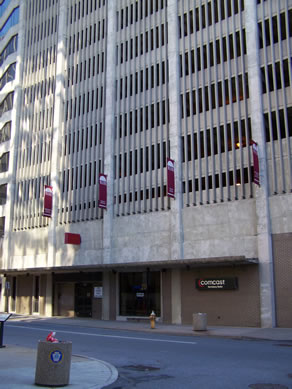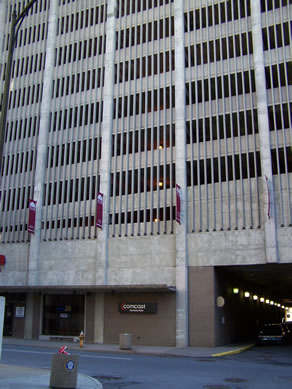Harrisburg on the eve
of Civil War
Study Areas
The Violent Decade
History of the old Dauphin County Prison
Southeast corner of Walnut and Court streets, Harrisburg, PA
Now occupied by a modern office building, the southeast corner of Walnut Street and Rasberry Alley (later renamed Court Alley) was once the site of the Gothic style, granite-walled Dauphin County Prison. Designed by architect John Haviland, it was built in 1840 to abut the county courthouse, which stood direclty behind it and fronted on Market Street. It replaced the original town jail, which stood on the northwest corner of Strawberry and Rasberrry alleys. Prisoners convicted in court could be taken out of the back door of the courthouse, through a walled courtyard, directly into the back entrance to the prison.
The site is one of several parcels of land originally donated by John Harris, Jr. for public use. John Haviland, who had designed Eastern State Penitentiary, in Philadelphia, designed the Harrisburg prison with an octagonal bell tower, to sound an alarm in the event of trouble, and forty sturdy cells. The entire structure was set back from the street and surrounded by an intimidating cast iron fence. The courtyard to the rear was enclosed with limestone walls, twenty-three feet in height.
The prison consisted of two distinct parts. Fronting on Walnut Street was the two-story, turreted, Gothic Revival style, granite office and residence of the prison-keeper. Connected to it by a ten-foot-wide corridor was the limestone prison itself. The prison contained forty cells, each seven-and-one-half feet wide by fifteen feet long. Twenty cells were on the first floor and twenty on the second floor, arranged ten on each side of a ten-foot-wide, eighty-foot-long, brick-paved corridor. Each cell contained one bed and a toilet, was heated by hot water and ventilated by holes in the external wall. The only natural light was from skylights in the ceiling of the common corridor.
The structure was staffed by a prison-keeper, who oversaw the entire operation, a matron, to attend to female inmates, a physician, an under-keeper, who assisted the prison-keeper, and a superintendant of the weaving operation. Prisoners worked to produce cloth, which was sold to help offset the costs of maintaining the prison. Items such as cloth bags, carpeting, and material for pants and shirts, was produced for sale to local merchants.
Confining Fugitive Slaves
Captured fugitive slaves were frequently held in the county prison. This practice led to Harrisburg's most notorious fugitive slave riot, which occurred in August 1850. Three fugitive slaves had been captured in town on charges of horse stealing, and their return was sought by several Clark County, Virginia slave catchers, led by George H. Isler and William Taylor. The presiding county judge, John J. Pearson, decided that Isler and Taylor did not have enough evidence to charge the fugitives with horse stealing, and he suspected their true intent was to have the county hold the three men until they could bring help to Harrisburg to capture them as fugitive slaves.
Pearson ruled that the three fugitive slaves should be set free from the prison, but Isler, Taylor, and seven more Virginians were waiting for them at the prison's Walnut Street front door. When the three fugitives entered the small vestibule, in which the Virginians were gathered, the slave catchers immediately began beating the just released men, in an attempt to subdue them. Unfortunatley for the Virginians, a large crowd consisting mostly of local African American residents had gathered to witness the release of the captives, and they were enraged by the brutal recapture attempt.
A riot broke out as the crowd, separated from the slave catchers by the prison's cast iron fence and a thin ring of constables, hurled rocks, bricks and crockery at the Virginians. Their efforts were in vain until a man from the crowd, thirty-one-year-old Joseph Pople, ran to the iron fence and forced it open with a large wooden club. Pople then ran into the vestibule and began fighting with the Virginians. This surprise attack succeeded in allowing one of the fugitive slaves to escape into the crowd, but the nine Virginians soon overpowered Pople and the remaining two slaves.
Outside of the fence, order was only restored when fifty deputized men under the command of Major Jacob Seiler, marched from the state arsenal on Capitol Hill straight down Walnut Street to the prison entrance. The hastily organized militia scattered the mob with fixed bayonets, then formed in ranks at Third and Walnut streets, reinforced by a cannon, which was pointed direclty toward the African American neighborhood of Tanner's Alley.
From The Year of Jubilee, Men of Muscle:
Once the streets were cleared, the militiamen were deputized by Sheriff Shell to round up those who were known to have participated in the riot, and within hours several of the town’s most well known African American citizens were under arrest for riot. Bound over by the court were Doctor William Jones, barber Henry Bradley, James Williams, Joseph Pople, and six other free African American residents of Harrisburg. In the afternoon, nine of the Southerners were also arrested and charged with inciting a riot. Judge Pearson set trial dates for the November court of quarter sessions to sort it all out. (p.31)
Previous Next
![]()
![]()
All photographs and text on this page copyright © 2011 George F. Nagle and Afrolumens Project.
Resources
- Egle, William Henry, Notes and Queries, 1879-1895
- Frew, Ken, Building Harrisburg, 2009
- Morgan, George H., Annals of Harrisburg, 1858.
Notes and Links
Of Interest Nearby




